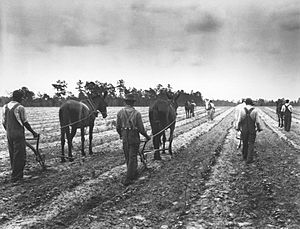Cotton-Holiday facts for kids

The Cotton-Holiday was a big idea in 1931. It was proposed by Huey Long, who was the Governor of Louisiana and was about to become a US Senator. His goal was to help farmers who had grown way too much cotton.
The idea was simple: if farmers stopped growing cotton for a whole year in 1932, there would be less cotton available. This would make the price of cotton go up, helping farmers earn more money. Some people say this was the first time someone suggested creating a "shortage" on purpose to fix a problem during the Great Depression.
Contents
Why Was the Cotton-Holiday Needed?
Too Much Cotton, Too Little Money
In 1931, farmers grew a huge amount of cotton. It was a record crop, over 15.5 million bales! This was much more than anyone expected. Because there was so much cotton, its price dropped really low.
The price of cotton was the lowest it had been since 1905. Farmers were losing money because it cost them more to grow the cotton than they could sell it for. This made the hard times of the Great Depression even worse for cotton farmers.
Early Ideas to Help Farmers
The Federal Farm Board (FFB) was a group trying to help farmers. Its leader sent a message to the governors of 14 states that grew cotton. He suggested that farmers should be forced to destroy some of their cotton. The idea was to plow under about one-third of their cotton plants. This would have destroyed about 4 million bales of cotton. However, many people did not like this idea.
Huey Long's Big Idea
What Was the Cotton-Holiday Plan?
Huey Long had a different plan. He suggested that all cotton-growing states should make a law for a "cotton holiday" in 1932. This meant that no cotton at all would be grown that year.
Long sent his idea to other governors. He invited them to a meeting called the New Orleans Cotton Conference. He also thought the holiday should happen in other countries too, like Egypt, to protect prices everywhere. Some countries were interested in his plan.
The Meeting and the Vote
Delegates from all the main cotton-producing states came to the 1931 meeting. Another plan from Texas suggested only cutting cotton production by half. But Long's idea won. The delegates agreed to make Long's plan into a law.
However, there was a catch. The law would only go into effect if states that produced three-quarters (75%) of all US cotton passed it.
Why the Plan Failed
Louisiana, Long's home state, quickly passed the law. But the governor of Texas, Ross S. Sterling, thought the idea was too extreme. Texas grew the most cotton in the country. When the Texas lawmakers voted, they said no to the cotton holiday. Because Texas didn't pass the law, the whole idea fell apart.
Huey Long claimed that Texas lawmakers were paid off to stop his plan. Texas did pass a different law. It said that farmers could only use 30% of their land to grow cotton. But this law was hard to make sure people followed. It was also found to be against the law in 1932. Other states like Mississippi and Arkansas passed similar laws, but they had rules that let them end the laws quickly.
What Happened Next?
Even though the Cotton-Holiday plan didn't work, it made Huey Long very famous across the country. He became known as a champion for poor people.
Senator Carter Glass, who was often against Long, later said something interesting. He said that the idea of "creating a shortage" to fix the economy didn't come from President Franklin D. Roosevelt or his Secretary of Agriculture. Instead, he gave credit for this "peculiar notion" to Huey P. Long.

